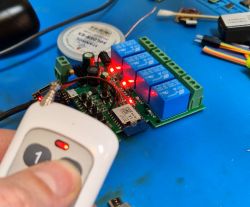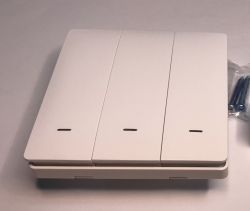FAQ
TL;DR: TP4056 + bare solar often won’t restart a flat 18650; use a solar-aware charger (e.g., CN3065, 500mA) or add load disconnect; "TP4056 is not suitable for charging from a 'bare' photovoltaic panel." [Elektroda, kaczakat, post #20161807]
Why it matters: Makers running ESP8266 + 18650 + solar need reliable sunrise recovery without babysitting or bench recharging.
Quick Facts
- TP4056 drastically reduces charge current below ~2.9V; disconnect the load until the cell recovers to avoid stalemate. [Elektroda, TvWidget, post #20162113]
- CN3065 suits small solar but caps PV input at approx. 6.5V; a 7.2V panel needs a drop element, adding loss. [Elektroda, krawietz, post #20161847]
- ESP8266 nodes draw approx. 150–200mA active; plan charge current comfortably above this to charge and run. [Elektroda, krawietz, post #20162285]
- TP4056 lacks PV tracking; it can pull the panel off its knee and stop charging under changing light. [Elektroda, kaczakat, post #20161807]
- Field data: a 6W panel delivered 0.8A in sun vs 0.92A Isc rating; leave margin for clouds and mornings. [Elektroda, krawietz, post #20161673]
Why doesn�t my TP4056 start charging when the 18650 is at ~2.8�2.9V?
Below about 2.9V, the charger enters a low-current precharge mode. Your ESP load can exceed that reduced current. The result is no net battery charging and no recovery. Disconnect the ESP until the cell voltage rises, then reconnect once normal charge current resumes. [Elektroda, TvWidget, post #20162113]
Is TP4056 suitable for direct solar-panel charging?
No. "TP4056 is not suitable for charging from a 'bare' photovoltaic panel." It draws a fixed current, collapses the PV voltage, then shuts off and can oscillate. Use a solar-aware charger that regulates panel operating point. [Elektroda, kaczakat, post #20161807]
My charger�s red LED is on, but the battery isn�t recovering. Why?
The LED shows the charger state, not net battery gain. If the panel only provides about 0.04A while the ESP draws more, the battery sees no charge. This looks like "charging" yet never raises cell voltage. Try with the ESP disconnected to confirm. [Elektroda, krawietz, post #20161673]
Will a CN3065 work with a 7.2V solar panel?
Not directly. The CN3065�s PV input is around 6.5V max. A 7.2V panel needs a series drop (e.g., diode), which wastes power and heat. Consider a charger with a higher PV input range instead of burning headroom. [Elektroda, krawietz, post #20161847]
Is CN3791 a better choice for higher panel voltages?
Yes. CN3791 supports a larger PV input range than CN3065, making it a better fit for ~7.2V panels. It is designed for solar charging scenarios where panel voltage exceeds 6.5V. [Elektroda, krawietz, post #20162285]
How can I guarantee the node boots when sun returns?
Ensure charge current exceeds load at the battery terminals. Add a low-voltage disconnect so the ESP stays off until the cell recovers. "You must ensure that in each case the former current is greater than the latter." Measure and enforce this with a cutoff. [Elektroda, TvWidget, post #20162217]
How do I size panel and charge current for an ESP8266?
Start from the load: an ESP8266 can draw 150�200mA active. Your charger must deliver more than that at battery voltage to both run and recharge. Extra headroom improves cloudy-morning recovery. Match panel and charger so net charge remains positive during operation. [Elektroda, krawietz, post #20162285]
How can I test whether load current blocks recovery?
Use a regulated supply to power the node from 2�4V and record current draw versus voltage. Compare that curve to your charger�s available current from the panel. If the load exceeds precharge current below ~3V, add a disconnect. [Elektroda, TvWidget, post #20162217]
Will adding a 5V step-up help sunrise start-up?
Usually not. The boost converter adds conversion loss, so less solar energy reaches the battery. In testing, a step-up caused notable losses and didn�t solve the root cause. Prefer a solar-aware charger and a low-voltage disconnect. [Elektroda, krawietz, post #20162285]
What low-voltage cutoff should I use to protect the 18650?
Implement a cutoff that disconnects the ESP when the cell is too low, then reconnect after partial charge. The exact voltage depends on your cell and load curve. Measure load current versus voltage and set the threshold so charging can resume reliably. [Elektroda, TvWidget, post #20162217]
How do I recover a deeply discharged pack and avoid repeats?
- Disconnect the ESP8266 from the battery and charger output.
- Charge the cell from a stable source until voltage rises above the low-voltage threshold and current increases.
- Reconnect the ESP only after normal charge current resumes and the cell holds voltage.
[Elektroda, TvWidget, post #20162113]
Why did it work for 35 days and then fail after a full discharge?
While the cell had charge, the panel delivered up to 0.8A, running the ESP and charging. After deep discharge, the charger’s precharge and the ESP load conflicted, so sunrise didn’t restart the system. The LED can show charging while net current is near zero. [Elektroda, krawietz, post #20161673]
Any architecture alternative if my app must be always-on?
Yes. Run a second ESP on mains as a proxy or display, and let the solar ESP sleep and send updates. The proxy fetches from the cloud (e.g., ThingSpeak) to stay live while the battery node conserves energy. [Elektroda, kaczakat, post #20166017]
How can I cut ESP8266 power use on battery?
Use deep sleep and a low-Iq regulator. An HT7333 draws about 4�1A, and the ESP can sleep near 14�1A. Sampling every 15 minutes slashes average consumption by roughly 100�7, dramatically extending runtime. [Elektroda, kaczakat, post #20162743]






